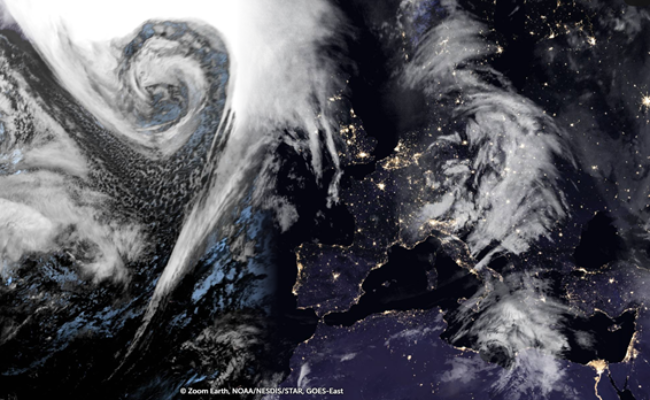
On February 9th, a British Airways Boeing 747 landed in London Heathrow airport just four hours and 56 minutes after its take-off in JFK, New York, setting the shortest flight-time for non-supersonic jets over this route. The jumbo jet took advantage of the fast upper-tropospheric winds associated with an exceptionally strong jet-stream which created tail winds of about 400km/h. Over the United Kingdom, the left exit region of the jet helped produce Storm Ciara causing widespread wind and flooding damage and 11 fatalities across Europe. The Eiffel tower was closed in Paris due to wind-gusts up to 130km/h. After a few days, on February 12th, the monster cyclone Uta (see satellite image) developed over the North Atlantic leading to very intense snowfalls and wind in the Arctic region, Iceland, Ireland and Scotland. Due to the heavy snowfalls, Arctic ice-cover is setting a positive record for the period 2001-2020 while southern European regions recorded very high temperatures due to the strong southerly winds. The exceptional nature of this phenomenon is linked to its unusual size: Uta is about twice as larger (in diameter) than an average extratropical cyclone.
What is the origin of these phenomena? Can their occurrence be connected to the increase in anthropogenic emissions? This question will challenge the climate-science community for the next few years. We can however find some hints of the answers in the published literature. So far, the circulation during this winter has been very “zonal”: this means that the low pressure around the North Pole (a.k.a. the Polar Vortex) was very compact and symmetric around the pole. This has reinforced the jet-stream and favored the development of those monster cyclones. Interactive analyses have proven this circulation to be very extreme and basically unobserved at least since 1948, the beginning of high-quality reconstructions of atmospheric circulation fields. Winter is usually characterized by some “blocking” events, where the polar vortex large oscillations which favor cyclones travelling in meridional direction leading to cold outbreaks and heavy snowfalls. This was the case of the winters 2009-2010 and 2012-2013. Blocking is however mysteriously absent from our current winter , raising questions about possible modifications in the atmospheric circulation induced by climate change.
Finding any climate change signal in these phenomena has proven challenging due to the chaotic nature of the atmospheric circulation and the presence of large inter-annual variability. The climate community is currently divided between studies showing an increase in zonal flow configurations and others showing an amplification of the polar vortex, leading to blocking and cold air outbreaks. According to a recent study the controversy depends on the fate of Arctic warming. On the basis of the currently available simulations, scientists tend to prefer the hypothesis of an increase in the zonality of the flow, and this has been recently linked to warmer oceans. Following this hypothesis, more monster cyclones will be on their way and planes will fly faster to Europe from North America. Passengers should also be aware that the increase in the high-level jet winds will also lead to increasing turbulence: faster flights with seat-belts fasten.

Giorgio vacchiano
I thought that the consensus was that arctic amplufication leads to a weakening of the jet stream, hence to deeper Rossby waves and blocking events? Is there literature suggesting the opposite?
Thank you
Davide Faranda
Dear Giorgio, Thanks for your comment. Indeed in the last years it seems that there is a lack of consensus. I can point to few recent articles and then suggest you to look at the references therein:
1) Dai and Song 2020 ” Little influence of Arctic amplification on mid-latitude climate ” https://www.nature.com/articles/s41558-020-0694-3
2) Cohen et al 2019 “Divergent consensuses on Arctic amplification influence on midlatitude severe winter weather” https://www.nature.com/articles/s41558-019-0662-y
cheers,
Davide